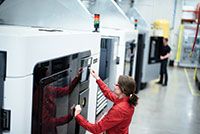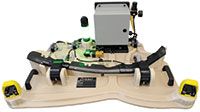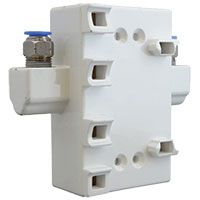by Staff Writer | Photos Solaxis Ingenious Manufacturing Inc.
Quebec 3D printing firm redefines the meaning of ingenious
THE PROBLEM
How to produce specialized workholding and other tooling in less time at a lower cost
THE SOLUTION
Use additive manufacturing to 3D print jigs, fixtures, robotic grippers and more
The aerospace industry makes extensive use of very large jigs and fixtures, tooling renowned for its extreme weight, lead times and price tags. In response, François Guilbault and his team at Solaxis Ingenious Manufacturing Inc. of Bromont, Que., sought to break this paradigm by using different materials to build tools that are lighter and easier to handle; can be produced in less time; and have more attractive prices than their metal equivalents.
The material used to make this specialty tooling isn’t a fancy new lightweight type of tool steel or high strength aluminum, but rather plastic, the stuff of soda bottles and leftover food containers. Using a fleet of large format FDM (fused deposition modeling) 3D printers, Solaxis turns high-strength polymers like PEKK, carbon-filled Nylon, and Ultem 1010 into inspection and assembly jigs, masking and layup tooling, dies for thermo and vacuum forming, ergonomic hand tools, and a host of similar production-grade tooling.
 This unlikely combination of polymers and a 3D extrusion process—admittedly far less accurate than CNC machining, EDM, and grinding—to produce production tooling might leave the industrial engineers in the room shaking their heads. But these plastic tools lets you skip the fork trucks and long lead times without sacrificing accuracy and rigidity.
This unlikely combination of polymers and a 3D extrusion process—admittedly far less accurate than CNC machining, EDM, and grinding—to produce production tooling might leave the industrial engineers in the room shaking their heads. But these plastic tools lets you skip the fork trucks and long lead times without sacrificing accuracy and rigidity.
Rapid prototyping equals rapid growth
Like the 3D printing industry itself, Solaxis has dealt with significant changes—and challenges—since Guilbault first opened the doors of this small additive manufacturing (AM) firm in 2010. What began as two engineers with the shared vision of “let’s see if we can print some aerospace parts” has become a rapidly growing, high-tech manufacturer known for its proficiency at designing and producing large format 3D-printed products.
 Its customers include aerospace and defence firms, where functional prototypes and flight-certified components such as ventilation ducts and aircraft panels are common fare. The company also makes propellers, guards, and fasteners for industrial uses, as well as seats, tanks, steering wheels, and more for automotive or ground transportation applications.
Its customers include aerospace and defence firms, where functional prototypes and flight-certified components such as ventilation ducts and aircraft panels are common fare. The company also makes propellers, guards, and fasteners for industrial uses, as well as seats, tanks, steering wheels, and more for automotive or ground transportation applications.
Solaxis and its ten employees operate a pair of Fortus 400mc and seven F900 Gen III FDM printers from Stratasys, the latter with a build envelope of 914 x 609 x 914 mm (36 x 24 x 36 in.). Any parts larger than this can be spliced together, allowing Solaxis to deliver components and tooling two or more metres in length, such as floor panels for recreational vehicles and oversized recycling containers. They’ve also moved into the laser-based AM realm by investing in “open” SLS (selective laser sintering) printers from Farsoon Technologies, a step that Guilbault admits was a bit of a gamble.
“Like us, Farsoon is a relatively new company,” he says. “The equipment is assembled in China but uses American components, with most of the electronics coming from Schneider Electric. But we know that Farsoon has been working with Airbus, so that helped to increase our confidence level, and together with the virtue of it being an open materials system was enough to bring us on board.”
 Opening doors
Opening doors
Guilbault is talking about the use of non-proprietary powders from suppliers such as BASF, materials that cost less than those from 3D printer manufacturers who require that customers use only approved powders, resins, reels, and similarly “closed” feedstocks. Not only do open systems reduce material costs—which often represent a significant chunk of the finished product’s price—but they allow more latitude in terms of machine settings and operating parameters. This gives manufacturers like Solaxis greater freedom to develop their own recipes and techniques that might generate a competitive advantage.
In one example, an industrial manufacturing customer requested a lightweight end-of-arm tool (EOAT) for a robotic application. Solaxis designers took what was originally a 22-component assembly design and reduced it to just five 3D-printed components. This cut the gripper’s weight by 70 per cent, allowing the customer to increase the robot’s speed and throughput. In another EOAT application, a hybrid aluminum-polymer was used, delivering a lighter tool that provided greater performance.
Solaxis saw similar success with a vehicle manufacturer who needed an assembly jig for a critical sealing component, a jig that could simultaneously validate product compliance. The new tool measured 863 mm x 558 mm (34 in. x 22 in.) and weighed just 12.7 kg. (28 lbs.), 80 per cent lighter than its aluminum predecessor. Furthermore, the tool’s ergonomic design allowed the operator to produce 15 per cent more parts per shift, and by integrating a series of fiberoptic fibers and go/no-go sensors, product quality was assured.
Turn up the volume
Just because Solaxis has large format FDM equipment doesn’t mean all of the parts produced on it are supersized. As Guilbault explains, they have the option of loading the machine table with multiple small parts, often from different jobs. Because the Stratasys equipment has automatic spool changing capabilities, they can then let the printer run unattended for shifts or even days at a time. This tactic is also being used on the newer SLS equipment, where nests of parts can fill the build chamber to its maximum height, significantly improving machine utilization.
“Solaxis has had great success over the years,” says Guilbault. “We’re now pushing into the medical sector and are developing our own in-house testing capabilities to ensure 3D-printed part quality. I’ve found that large format 3D printers give us economies of scale not possible with smaller machines, together with the flexibility to take on big work as needed. And for components that exceed our printing range, my designers have developed some very robust joining methods that eliminate any potential for delamination and allow us to build practically any size part requested. Granted, it’s been a steep learning curve for all of us, but I’m quite pleased with our direction and look forward to continued growth.” SMT
